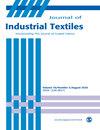Investigation of flexural performance of concrete beams with nonwoven/polymer composites versus steel-rebar reinforcement
IF 2
4区 工程技术
Q1 MATERIALS SCIENCE, TEXTILES
引用次数: 0
Abstract
The research investigates the unique characteristics and benefits of using nonwoven fabrics and polymer I cross-section composites in concrete beams. These materials show improved strength, flexibility, and corrosion resistance compared to conventional steel-reinforced beams, offering promising solutions for various construction applications. This study constructed an I-beam structure using a nonwoven polyester fabric/polyester composite cast in a concrete beam. Other designs included woven carbon fabric or Kevlar nonwoven fabric applied to the bottom flange of the I-beam for reinforcement. The flexural behavior of an I-beam polyester nonwoven/polyester composite with Kevlar or carbon-reinforced concrete beams was examined. The comparison between the different samples indicates that: flexural strength: the carbon sheet-reinforced sample exhibits the highest flexural strength, followed by the steel rebar and Kevlar-reinforced samples. The ductility: The steel rebar-reinforced sample shows the highest ductility, indicating better deformation capacity before failure. Carbon sheet reinforcement also provides substantial ductility. Bending stiffness: The highest bending stiffness is observed in the Kevlar-reinforced sample, suggesting a stiffer and less flexible beam. These observations highlight the trade-offs between stiffness, strength, and ductility in reinforced concrete beams. The reinforcement material choice depends on the application-specific requirements, such as the need for higher bending strength, better flexibility, or greater stiffness.无纺布/聚合物复合材料与钢筋加固混凝土梁抗弯性能对比研究
该研究调查了在混凝土梁中使用无纺布和聚合物 I 型截面复合材料的独特特性和优势。与传统的钢筋梁相比,这些材料的强度、柔韧性和耐腐蚀性都有所提高,为各种建筑应用提供了前景广阔的解决方案。这项研究利用浇注在混凝土梁中的无纺聚酯织物/聚酯复合材料建造了一个工字梁结构。其他设计还包括在工字钢底部翼缘采用碳纤维编织物或凯夫拉无纺布进行加固。研究了工字钢聚酯无纺布/聚酯复合材料与 Kevlar 或碳纤维加固混凝土梁的弯曲性能。不同样品之间的比较表明:抗弯强度:碳片加固样品的抗弯强度最高,其次是钢筋和凯夫拉纤维加固样品。延展性:钢筋加固的样本显示出最高的延展性,表明其在破坏前具有更好的变形能力。碳板加固也提供了很大的延展性。弯曲刚度:凯芙拉纤维加固样本的弯曲刚度最高,表明梁的刚度和柔性较低。这些观察结果凸显了钢筋混凝土梁在刚度、强度和延展性之间的权衡。加固材料的选择取决于具体的应用要求,例如需要更高的抗弯强度、更好的柔韧性或更大的刚度。
本文章由计算机程序翻译,如有差异,请以英文原文为准。
求助全文
约1分钟内获得全文
求助全文
来源期刊

Journal of Industrial Textiles
MATERIALS SCIENCE, TEXTILES-
CiteScore
5.30
自引率
18.80%
发文量
165
审稿时长
2.3 months
期刊介绍:
The Journal of Industrial Textiles is the only peer reviewed journal devoted exclusively to technology, processing, methodology, modelling and applications in technical textiles, nonwovens, coated and laminated fabrics, textile composites and nanofibers.
 求助内容:
求助内容: 应助结果提醒方式:
应助结果提醒方式:


